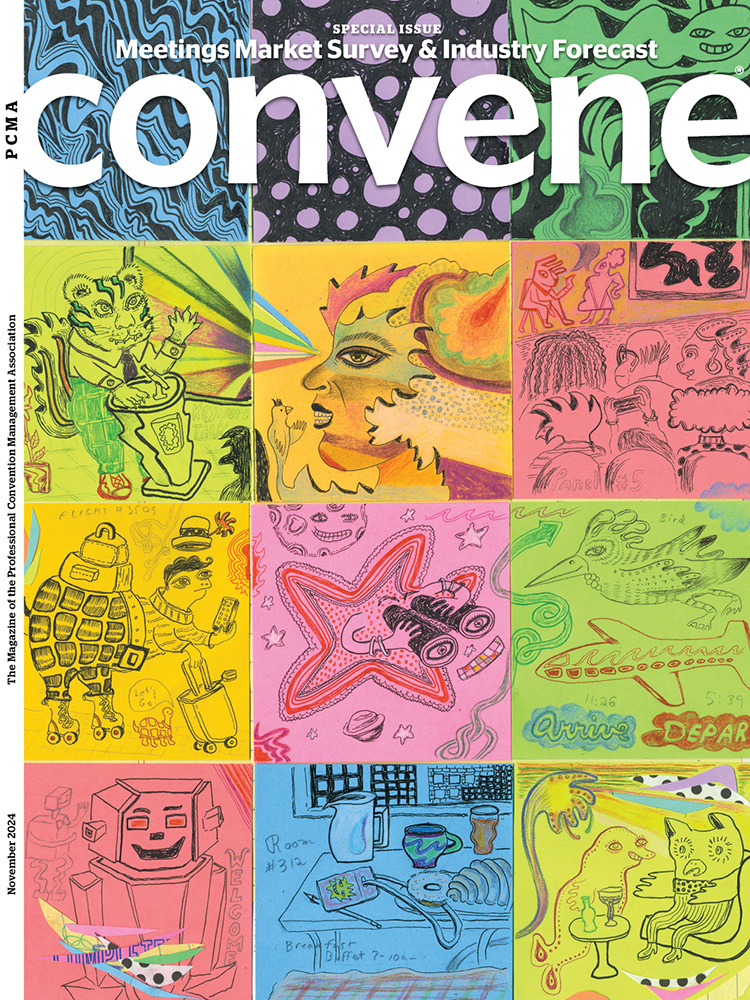The challenges highlighted by last year’s Meetings Market Survey respondents, unfortunately, haven’t gone away. Some, like rising costs and budgetary constraints, have become more acute, piling more pressures on an already stressful job. Planners have long occupied top spots on several most-stressful-jobs lists, and the role was included on job site Indeed’s most recent list this year. “Event planners are responsible for organizing and supervising every aspect of an event,” according to Indeed’s job description, adding that planners “deliver events with strict deadlines and budgets. They also have to oversee and direct a large number of activities.”
But those big responsibilities have long been table stakes for event organizers. Indeed’s description just scratches the surface, lacking additional post-pandemic challenges like skyrocketing F&B and AV expenses and working with smaller staffs — internally and externally — that often haven’t returned to prepandemic levels. On top of that, there’s the need to deliver on participants’ growing expectations for experiential and memorable events. In sum: Heightened expectations, higher costs, and budgets that don’t match up.
 While this year’s event organizer respondents expressed frustration that these challenges persist ever since the world got back to business after the COVID shutdown, there was also something of a sense of resignation or acceptance of certain realities and a determination to carry on — perhaps the result of having weathered the largest disruption the events industry has ever had to face.
While this year’s event organizer respondents expressed frustration that these challenges persist ever since the world got back to business after the COVID shutdown, there was also something of a sense of resignation or acceptance of certain realities and a determination to carry on — perhaps the result of having weathered the largest disruption the events industry has ever had to face.
Showing Resolve
In the metric most often associated with success, we have bounced back: Nearly half of event planner respondents said that attendance at their largest in-person meeting in 2024 exceeded participation levels prior to the pandemic, with only one in five indicating attendance has decreased. This is an improvement over last year, when only 40 percent said their 2023 attendance had grown beyond pre-pandemic levels and nearly three out of 10 said it was lower.
But last year, survey respondents were more optimistic about their budgets increasing in 2024 to keep pace with rising costs and attendee expectations — 64 percent thought they would have bigger budgets to work with. Less than half of this year’s respondents anticipate an increase in 2025. Perhaps that reflects that planners are more realistic about — or more used to — working with flat budgets and mounting costs. Nearly two out of five respondents (39 percent) expect their budgets to stay the same in 2025, compared to only one-quarter of planners in last year’s survey.
When it comes to taking measures to offset expenses, planners’ responses demonstrate their resourcefulness. Three out of five planners are sharpening their pencils and becoming more skilled negotiators, 55 percent are beefing up sponsorship opportunities, and 53 percent are judiciously cutting out event elements that carry an expense but don’t deliver ROI. Only around half have shifted costs over to attendees by raising registration fees.
People and Planet
Yet dealing with these harsh financial realities hasn’t forced event organizers to neglect the larger responsibilities of doing better for their audiences and the environment. At a time when corporations are scaling back on their DEI initiatives, planners are doubling down on inclusion, diversity, and accessibility. The majority (66 percent) of respondents have prioritized DEI initiatives at their events — including being intentional about hiring diverse suppliers, fine-tuning codes of conduct, choosing more diverse speakers and panelists, and engaging DEI committees — to ensure that they are welcoming and inclusive to all.
 And while other industry surveys suggest that, given their other challenges, planners are making sustainability less of a priority, responses to this year’s Meeting Market Survey indicate otherwise. Nearly double (60 percent vs. 31 percent in last year’s survey) are including sustainability requirements in their RFPs. One could argue that planners are relegating environmental responsibility to their suppliers, but another data point shows that they also are holding themselves accountable for their footprint: 42 percent have increased sustainability reporting internally and/or to attendees vs. 27 percent last year.
And while other industry surveys suggest that, given their other challenges, planners are making sustainability less of a priority, responses to this year’s Meeting Market Survey indicate otherwise. Nearly double (60 percent vs. 31 percent in last year’s survey) are including sustainability requirements in their RFPs. One could argue that planners are relegating environmental responsibility to their suppliers, but another data point shows that they also are holding themselves accountable for their footprint: 42 percent have increased sustainability reporting internally and/or to attendees vs. 27 percent last year.
Are planners more or less anxious about the future? It’s a tough call. Responses were mixed. Some are enthused about the opportunities that gen AI brings to their roles and industry overall and others expressed concern over its explosive growth and lack of oversight. Many planners said they are worried about the impact that big events — the U.S. election, wars, inflation, and climate change, to name a few — will have on their own events, the industry, and society. One planner captured why more than half of respondents said they were both excited and worried about what lies ahead: “The unknown is exciting but scary.”
The 31st Meetings Market Survey
-
- You’ll find the results — in written and graphics form — of this year’s Meetings Market Survey online in our November digital edition.
- Event Organizers Double Down on Sustainability
Magdalina Atanassova is Convene’s digital media editor. Michelle Russell is Convene’s editor in chief. We used ChatGPT for some of the survey analysis. Cover and other illustrations by Julie Murphy.
Annual Events Industry Forecast
Our usual approach to Convene‘s Annual Industry Forecast is to cast a wide net, gathering a variety of data related to the business events industry, including travel, lodging, technology, and the workplace. This year, we took a different tack. Instead of those wide-ranging forecasts, Convene editors wrote succinct trends reports for each sector. We’ve sifted through the research to come up with a few signposts to help you navigate the year ahead, whatever course it takes. And, as always, the Forecast includes our Annual Meetings Market Survey, which gives us a strong sense of where we stand at this moment in time — the ups, the downs, the challenges, and our overall mood.


